John Dollond, 1707-1761
Peter Dollond, 1731-1820
John Dollond, Jr., 1746-1804
George Huggins Dollond, 1774-1852
George Huggins Dollond 2, 1797-1866
William Huggins Dollond, 1834-1893
John Richard Chant, 1837-1920
Tyson Crawford, 1839-1930
by Brian Stevenson
last updated July, 2024
Early microscopes and other instruments from the Dollond family were of superior quality, and are now in high demand by collectors. The business began in 1750, when Peter Dollond completed his apprenticeship and opened an optician’s shop on the outskirts of London. He was soon joined by his father, John, who had been a silk weaver but was well educated in the sciences. Peter did not have any surviving sons, so he passed the business to his nephew and business partner, George Huggins Dollond. George did not marry, and passed the business to his nephew, who was also named George and similarly adopted the surname Dollond. His heir, son William, sold the Dollond business out of the family in 1871, although the name was retained. By that time, microscopes sold by Dollond appear to have been primarily made by other manufacturers. Production emphasis was placed on other products, such as binoculars and eyeglasses. Dollond and Company was purchased by James Aitchison in 1927, and renamed “Dollond and Aitchison”. The Dollond business name ended in 2015, when owner Boots Optical rebranded their shops. Examples of Dollond instruments from various eras are illustrated throughout this essay.
Some key dates for the Dollond business:
1750: Peter Dollond completed his apprenticeship, opened an optician’s shop in Spitalfields, London
1752: John Dollond joined Peter in the optical business
1759: John and Peter moved to The Strand.
1761: John Dollond died.
ca. 1765: Peter Dollond moved to St. Paul’s Churchyard.
1766: John Dollond Jr., Peter’s younger brother, became a partner
1804: John Dollond Jr. died
1805: Peter Dollond formed a partnership with his nephew, George Huggins, who then had his name changed to George Dollond.
1819: Peter Dollond retired, leaving full ownership to George Huggins Dollond
1820: Peter Dollond died
1852: George Huggins Dollond died. He left the business to his nephew, also named George Huggins, who then changed his surname to Dollond
1866: George Huggins Dollond 2 died, leaving the business to his son, William Dollond.
1871: William Dollond sold the business to John Chant, a former employee. The business became “Dollond & Co.”. Sometime afterward, Chant took Tyson Crawford as a partner.
1892: Chant and Crawford dissolved their partnership, and Crawford continued as sole owner of Dollond & Co.
1927: The business was acquired by James Aitchison, becoming “Dollond and Aitchison”.
2015: Owner Boots Optical rebranded all of their Dollond and Aitchison shops as “Boots”.
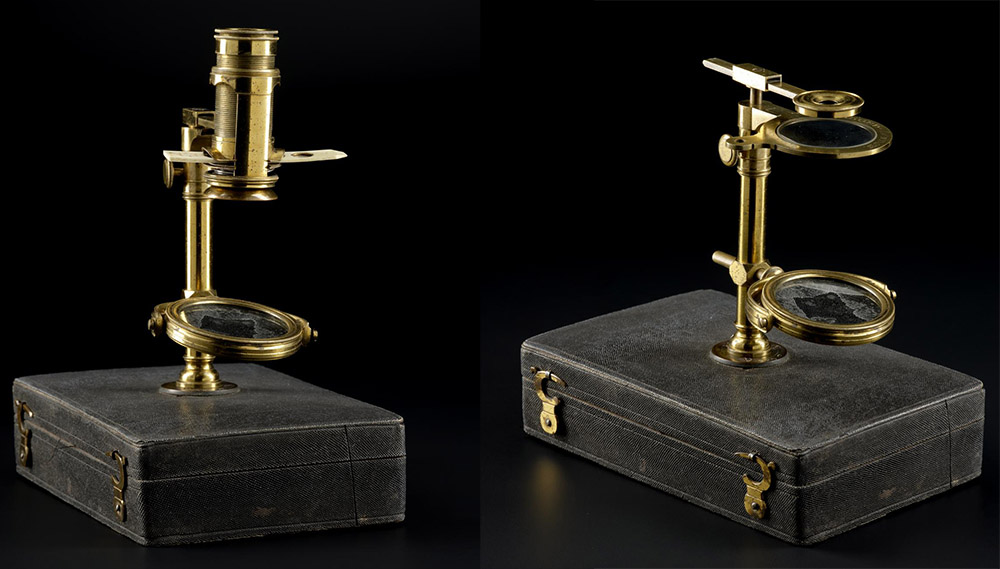
Figure 1.
A mid-1700s case-mounted microscope, signed on the stage "Dollond, London", with options for use as a screw barrel or Ellis-type aquatic simple microscope. Adapted for nonprofit, educational purposes from "https://www.nms.ac.uk/explore-our-collections/collection-search-results/microscope/799010.
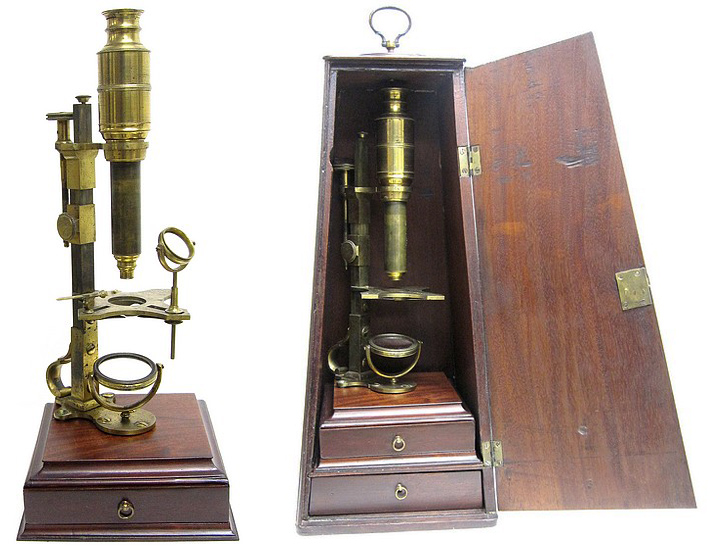
Figure 2.
A Cuff-pattern microscope by Dollond, mid-1700s. Adapted with permission, for nonprofit, educational purposes from "http://www.antique-microscopes.com/photos/Dollond_Cuff_microscope.htm.

Figure 3.
A “Nairne”-type chest microscope by Dollond. Adapted for nonprofit, educational purposes from "http://catalogue.museogalileo.it/object/ChestTypeCompoundMicroscope.html.
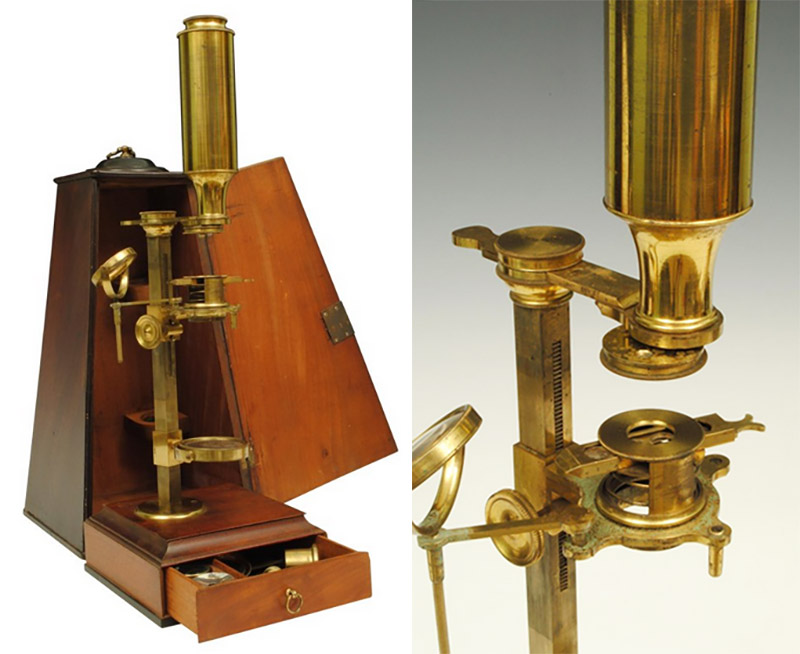
Figure 4.
A “Jones Improved” pattern microscope, by Dollond, circa 1800.
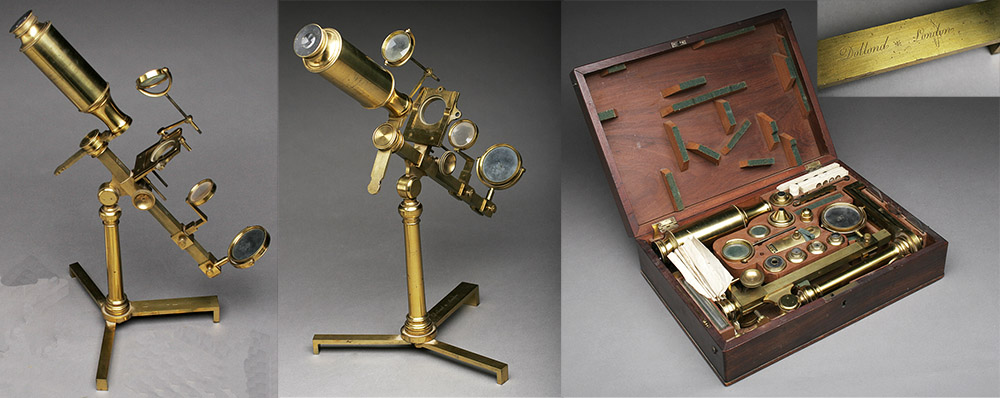
Figure 5.
A “Jones Most Improved”-style microscope, by Dollond, circa 1800.

Figure 6.
Circa 1810-1820 compound microscope by Dollond. Adapted for nonprofit, educational purposes from an internet auction site.
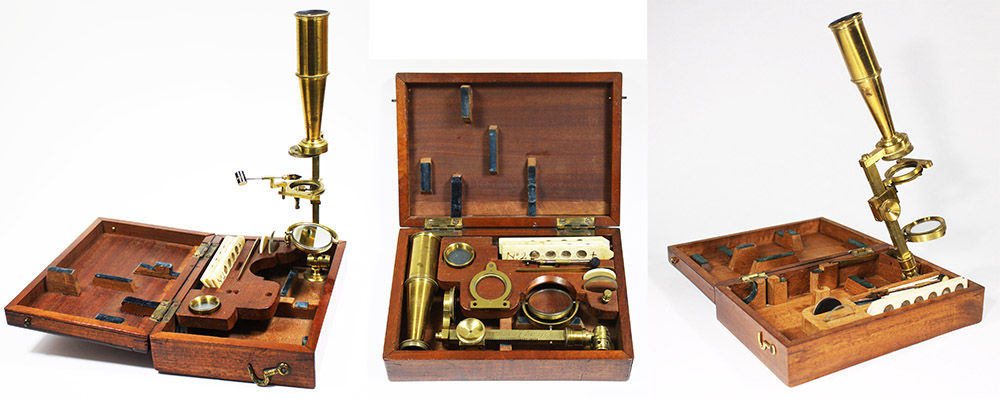
Figure 7.
Ca. 1820 Dollond compound / solar microscope compendium. Adapted for nonprofit, educational purposes from an internet sale site.

Figure 8A.
Two small, case-mounted microscopes by Dollond, ca. 1810-20. The instruments are permanently mounted into the cases on pivoting hinge, which allows them to be used at a comfortable angle and to be folded flat for storage. Note the different arrangements, apparently to suit the needs of each customer.
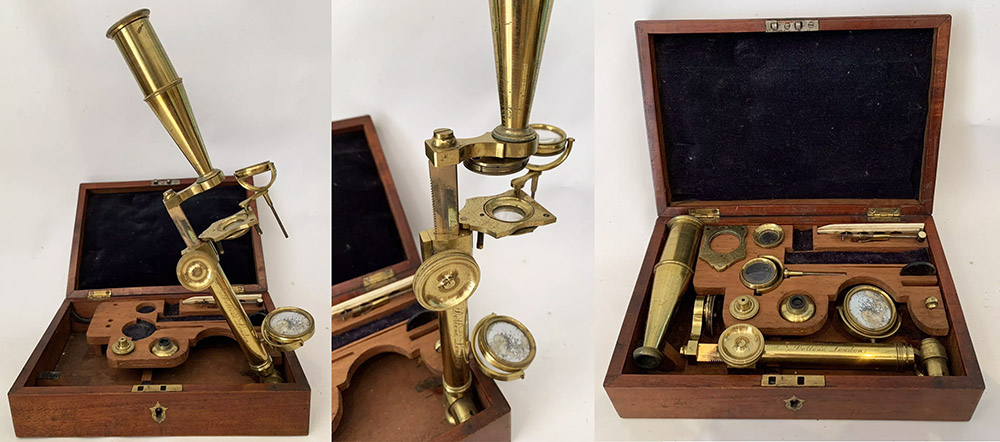
Figure 8B.
Similar to the microscopes shown in Figure 8A, this Dollond instrument has a cylindrical stem with an internal, triangular limb that operates on a rack-and-piston mechanism. Adapted for nonprofit, educational purposes from an internet auction site.
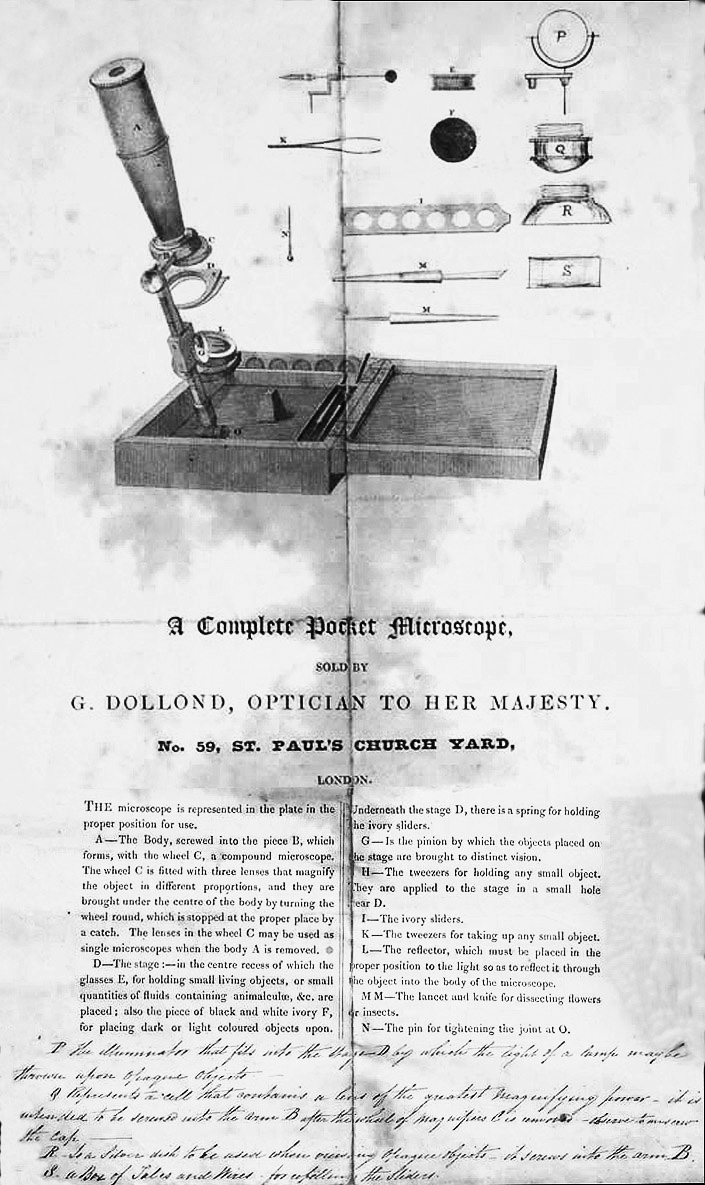
Figure 8C.
Circa 1820 description of George Dollond’s “Complete Pocket Microscope”, which appears to be a simpler version of the microscopes shown in Figure 8A, above. George took over the business from Peter Dollond in 1819. Adapted for nonprofit, educational purposes from an internet auction site.
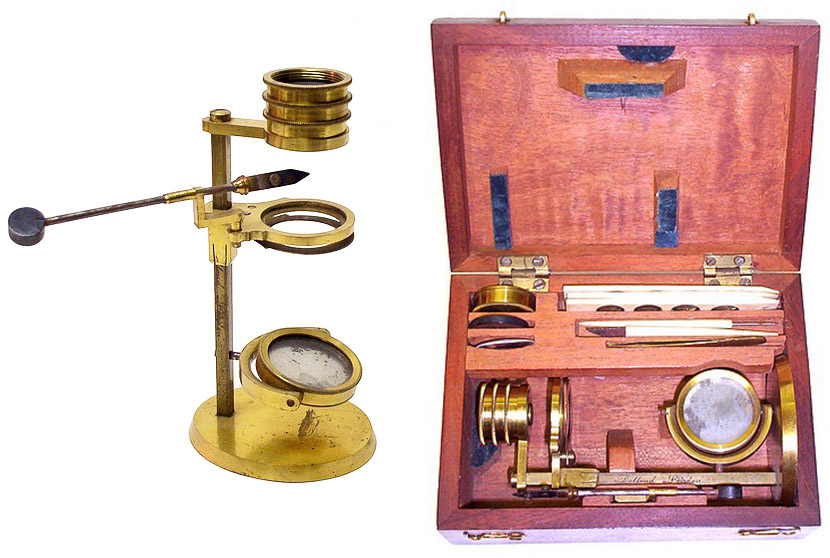
Figure 9.
Circa 1820 all-brass “Jones’ Botanical”-type microscope, signed by Dollond. Adapted by permission from "http://www.antique-microscopes.com/photos/dollond.htm.

Figure 1.
Two circa 1828 achromatic microscopes of unique design. George Dollond, the owner at that time, was known for his inventive designs. Adapted for nonprofit, educational purposes from "https://www.nms.ac.uk/explore-our-collections/collection-search-results/microscope-achromatic-compound/220432
and
"https://collection.sciencemuseumgroup.org.uk/objects/co416481/compound-microscope-with-tripod-stand-compound-microscope.
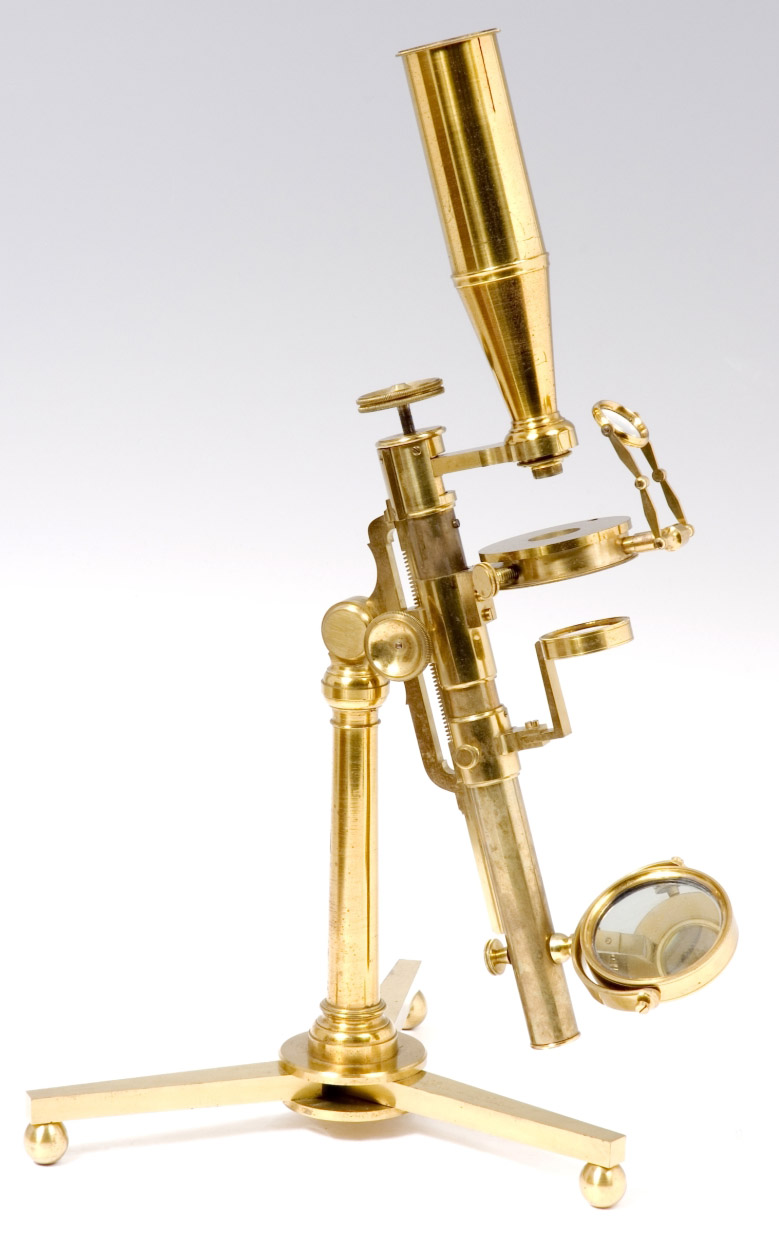
Figure 11.
A circa 1820s-30s Dollond microscope. Adapted for nonprofit, educational purposes from "https://www.mhs.ox.ac.uk/collections/imu-search-page/record-details/?thumbnails=on&irn=11703&TitInventoryNo=56603.

Figure 12.
Circa 1820s-30s “Wollaston Doublet” simple microscope by Dollond. Adapted for nonprofit, educational purposes from "https://collection.sciencemuseumgroup.org.uk/objects/co8182/wollaston-doublet-by-dollond-40-one-doublet.

Figure 13.
A different form of “Wollaston Doublet” microscope from Dollond, ca. 1830s. Adapted for nonprofit, educational purposes from "https://collection.sciencemuseumgroup.org.uk/objects/co8181/wollastons-doublet-microscope-by-dollond-microscope.
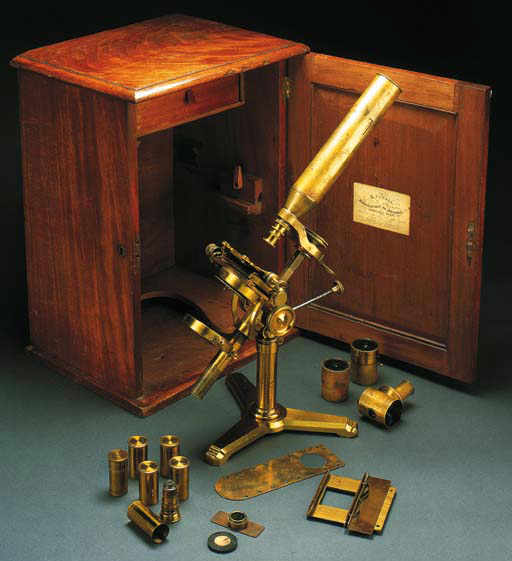
Figure 14.
Circa 1838 compound microscope, signed “Dollond, London”. It was probably made on commission by Hugh Powell, before that man established his renowned microscope business. Adapted for nonprofit, educational purposes from an internet auction site.
���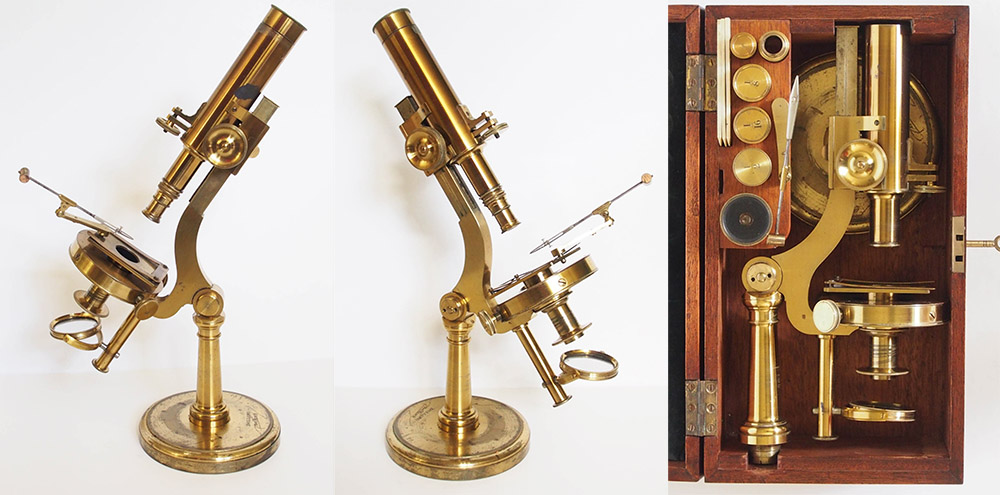
Figure 15.
Circa 1840 compound microscope, signed on the base “Dollond, London”. Probably also made by Hugh Powell. Adapted by permission from "https://www.microscope-antiques.com/powell.html.
���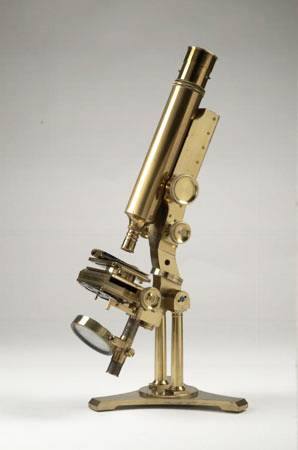
Figure 16.
Circa early 1840s “Newly Constructed Achromatic Microscope”, signed by Dollond but probably made by Powell & Lealand. This instrument was first described in a pamphlet published by that partnership in 1841. Adapted for nonprofit, educational purposes from "http://nms.scran.ac.uk/database/record.php?usi=000-180-000-924-C.
���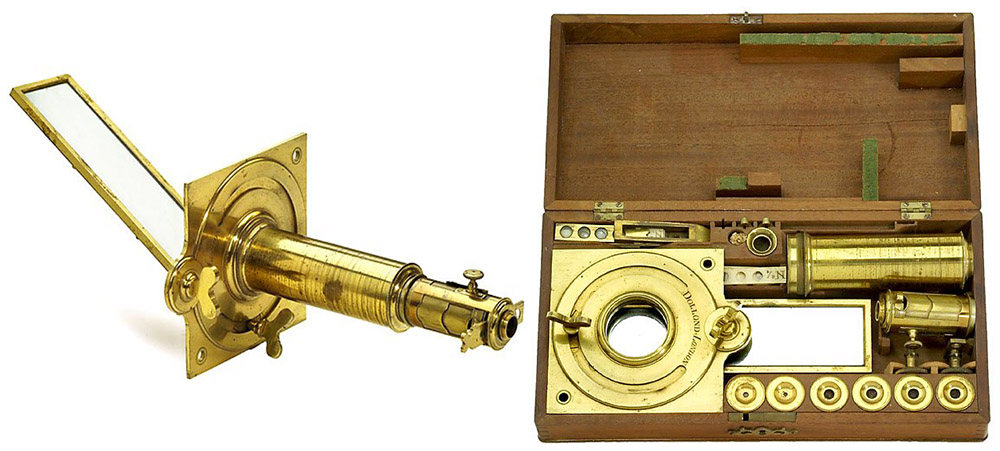
Figure 17.
Circa 1800 solar microscope by Dollond. Adapted for nonprofit, educational purposes from an internet auction site.
���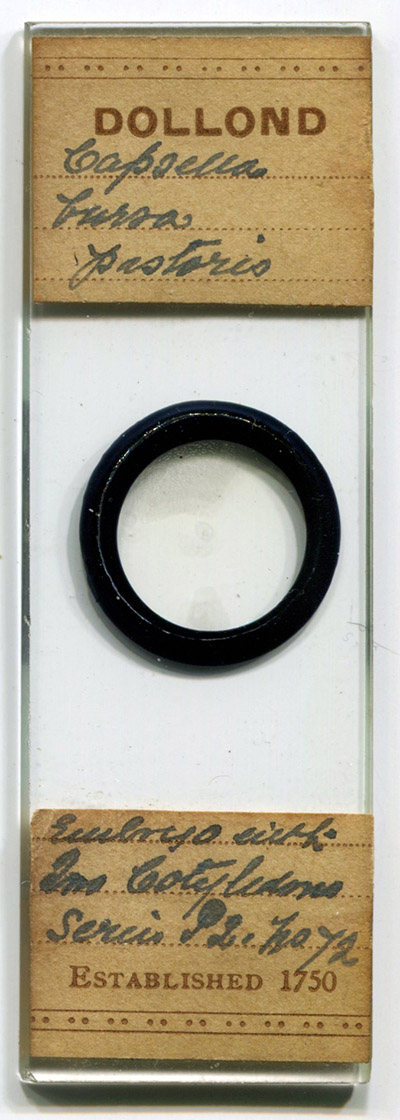
Figure 18.
A microscope slide that was sold by Dollond, from the later 1800s. The actual maker is not known. The specimen is a “Capsella bursa pastoris embryo with 2nd cotyledons” (i.e. a sprouting seed of a shepherd’s purse plant), and is marked as being part of a series. Another example of a Dollond-retailed slide is illustrated in Brian Bracegirdle’s “Microscopical Mounts and Mounters”, Plate 13-P; it is also part of a series of botanical preparations.
���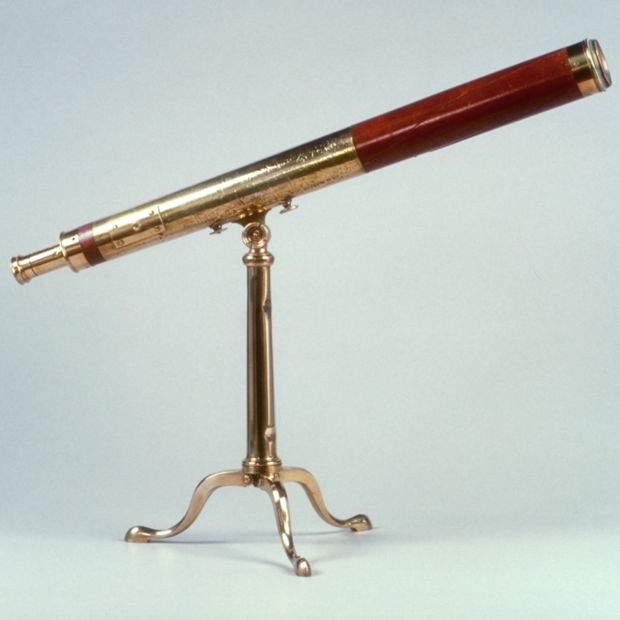
Figure 19.
Dollond achromatic telescope, purchased in 1786 by future US President Thomas Jefferson. Adapted for nonprofit, educational purposes from "http://classroom.monticello.org/kids/gallery/image/223/Telescope/
���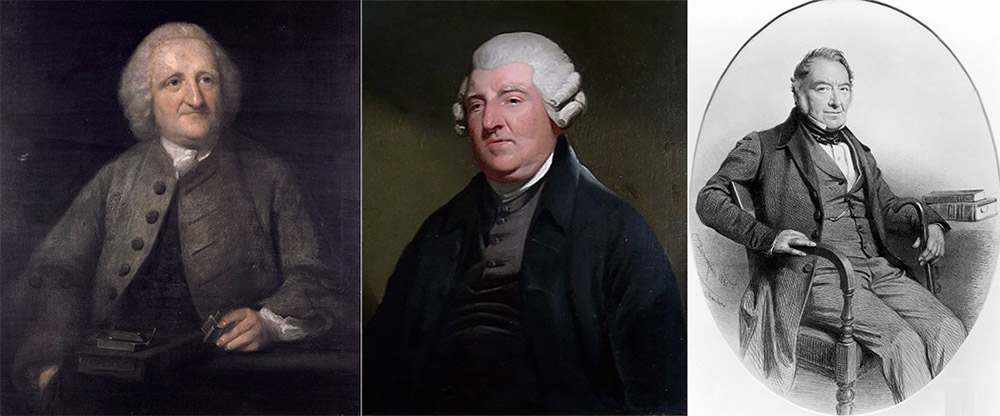
Figure 20.
John Dollond, 1707-1761 (left), his son, Peter, 1731-1820 (center), and John’s grandson / Peter’s nephew George Huggins Dollond (1774-1852). Images adapted for nonprofit, educational purposes.
���
Figure 21.
The Dollond family tree. Owners and their direct ancestors are named. The names of other children/siblings are omitted, among whom is Peter Dollond’s sister, Sarah, who married optician Jesse Ramsden.
���John Dollond’s parents, Jean and Susan Marie Cavelier Dollond, were Huguenot refugees from France who settled in Spitalfields, near London, around 1700. Jean was a silk weaver, and the French settlers of Spitalfields formed the center of silk weaving in England. Despite their poverty, the Spitalfields weavers valued education, and during the 18th century supported a Mathematical Society, a Historical Society, a Recitation (i.e. literature) Society, a Musical Society, a Floricultural Society, and an Entomological Society.
John (probably baptized as “Jean”) was born on June 10, 1707. He also became a silk-weaver. Yet he studied when able, and became proficient in mathematics, physics, and other topics, and learned Latin, Greek, French, German, and Italian. He similarly provided educations to his children.
The eldest son, Peter, initially followed the family trade. According to Kelly’s Life of John Dollond, weaving “neither suited the expectations nor disposition of the son, who, having received much information upon mathematical and philosophical subjects from the instruction of his father, and observing the great value which was set upon his father's knowledge in the theory of Optics by professional men, determined to apply that knowledge to the benefit of himself and his family; and, accordingly, under the directions of his father, commenced optician. Success, though under the most unfavourable circumstances, attended every effort”. Peter was thus apprenticed to an optical instrument maker. After obtaining his freedom, Peter established a shop in Vine Court, Spitalfields. Shortly thereafter, “in 1752, John Dollond, embracing the opportunity of pursuing a profession congenial with his mind, and without neglecting the rules of prudence towards his family, joined his son, and in consequence of his theoretical knowledge, soon became a proficient in the practical part of Optics”.
John Dollond patented a doublet lens for telescopes that was free of both chromatic and spherical aberration in 1758. He described his “achromatic” lens to the Royal Society, who awarded him the Copley Medal for the achievement. Despite claims from others of precedence in having created achromatic lenses, Dollond had developed a simple method of correcting spherical aberration, and a method for measuring lenses so that batches could be efficiently combined into achromatic doublets, thus enabling large-scale production.
John Dollond covered the expense of the achromatic lens patent application by forming a partnership in 1758 with Francis Watkins (1723-1792). Watkins paid the application fees, in return for a half-share of the profits.
In 1759, John and Peter opened a new shop in The Strand, London, a location that was much more convenient to affluent customers.
John was appointed as optician to King, George III in December, 1760. He was elected to membership in the Royal Society on May 28, 1761.
Not long afterward, on November 30, 1761, John Dollond was “seized with apoplexy, which rendered him immediately speechless, and occasioned his death in a few hours afterwards”.
Peter Dollond had married Ann Phillips a few months earlier, on August 16, 1761. They had two daughters and a son; the son appears to have died young. Around the same time, one of Peter’s sisters, Sarah, married Jesse Ramsden (1735-1800), who became a renowned maker of microscopes and other scientific instruments. She later separated from Ramsden, and moved into a house owned by Peter.
In 1763, Peter Dollond purchased Watkins’ share of the achromatic telescope patent for £230, and won termination of the contract by claiming that Watkins had broken the partnership by withholding profits.
Peter further defended the patent against other instrument makers who had been using the Dollond’s method of making achromatic telescopes. In 1764, he forced Martha Ayscough, widow of James Ayscough, to cease making such instruments. Several London opticians banded together to demand that Dollond’s patent be revoked, claiming that the achromatic lens had been invented earlier by someone else. Their petition was supported by the Spectaclemakers' Guild, whose Master was then Francis Watkins. The petition was rejected, and “in a series of cases between 1764 and 1768, Peter Dollond established his right to enjoy the privileges of the patent, and in so doing created a precedent in the case law on patents which was referred to in later judgments”.
Peter’s younger brother, John Jr., joined the Dollond business as a partner in 1766.
One of Peter and John Jr.’s sisters, Susan, married one William Huggins. Two of their sons, John and George, apprenticed as opticians with their uncles, in 1778 and 1788, respectively. George Huggins would later own the Dollond business. John Huggins’ son, also named George, would afterward inherit the business from his Uncle George.
The junior partner, John Dollond Jr., died on November 6, 1804.
The following year, 1805, Peter Dollond formed a partnership with his nephew, George Huggins. George then legally changed is surname to Dollond.
George was admitted to the Spectaclemaker’s Guild in 1807. The partnership contract between Peter and George was terminated in November, 1819, whereupon George took sole control of the Dollond business.
Peter had essentially retired some two years before the partnership’s dissolution. An 1820 obituary of Peter Dollond stated that “in the year 1817 he look up his residence at Richmond Hill, where he lived in great ease, and comfort, and respectability, till the 24th of June 1820. Having then removed to Kensington Common, being arrived at his 90th year, and nature being quite exhausted, he breathed his last on the 2d of July, in one deep sigh, and, without a struggle, closed his eyes on this world for ever”.
Through the following years, the Dollond firm was appointed as Optician to King George IV, King William IV, and Queen Victoria.
George Dollond was elected to membership in the Royal Society in 1819. He was also a founding member of the Royal Astronomical Society and the Royal Geographical Society. In 1823, George presented “A short account of a new instrument for measuring vertical and horizontal angles” to the Royal Astronomical Society
George did not marry. The 1841 national census shows him living in Surrey with an unmarried sister. His obituary later noted, “Mr. Dollond remained a bachelor; his constant friend and companion being his sister, Miss Huggins, an amiable lady, who died at his house at Camberwell, Jan. 31, 1849, aged 77”. The 1851 census reported George was still working as an “optician” at the age of 77. On census night, his household in Dulwich, Surrey, also included an unmarried “visitor” named Margaret Wilson, a cook, a housemaid, a coachman, and a footman.
George Dollond invented an instrument that he called "The Atmospheric Recorder, or self-registering apparatus for the various changes of the barometer, thermometer, hygrometer, electrometer, pluviometer, and evaporator, and of the force and direction of the wind". He earned a Gold Medal for this device at the 1851 International Exhibition in London.
George Dollond died on May 13, 1852. His will begins, “This is the last Will and Testament of one George Huggins Dollond variously known as George Dollond of 59 St. Paul’s churchyard in the city of London Optician I desire that I may be interred beside my late dear sister Susan in the vault of Norwood Cemetery & give and bequeath to my nephew George Huggins of Earl Street Blackfriars my leasehold messuages and premises at 59 St Paul’s churchyard and at No. 61 Paternoster Row”.
This nephew (hereafter George 2, for clarity), was a son of George Dollond’s elder brother, John Huggins. John had also apprenticed with Peter Dollond (see above).
An obituary of George Dollond included, “He is succeeded in business by his nephew, and able assistant, Mr. George Huggins, who, on the 18th June last, obtained the royal permission to assume the surname of Dollond, instead of Huggins, as his uncle had done before him in 1804”.
George 2 had married Mercy Simpson on July 21, 1821. They had five children. The eldest son, also named George was born in 1825, apprenticed as an optician with his father in 1839, but apparently died some time afterward. The second son, William, would eventually inherit the Dollond business.
By the mid-1800s, Dollond had become a relatively minor microscope dealer. Most, if not all, of the instruments that they sold were brought in from wholesale manufacturers (Figure 27).
George 2 died on September 22, 1866. The heir, William, was in poor health, and had difficulty operating the Dollond business. In mid-1871, William Dollond sold the firm to John Chant, who had previously worked for the Dollonds.
Chant sold off excess inventory, then moved to a shop at 1 Ludgate Hill and operated as “Dollond and Company” (Figures 26 and 28). Chant later took Tyson Crawford as a partner. That business ended in 1892, with Crawford continuing as sole owner of “Dollond & Co.” Record of the partnership dissolution described the business as “electrical and scientific apparatus makers”.
The firm was acquired by James Aitchison in 1927, becoming “Dollond and Aitchison”. Other owners followed, until the 2009 acquisition by Boots Optical, whereupon the shops were rebranded with Boots’ name.

Figure 22.
An invoice from Peter Dollond, dated May 16, 1763. His shop was still located on The Strand. The sale included a “complete microscopic apparatus”, a “5 foot achromatic telescope”, and a “camera obscura”. Adapted for nonprofit, educational purposes.
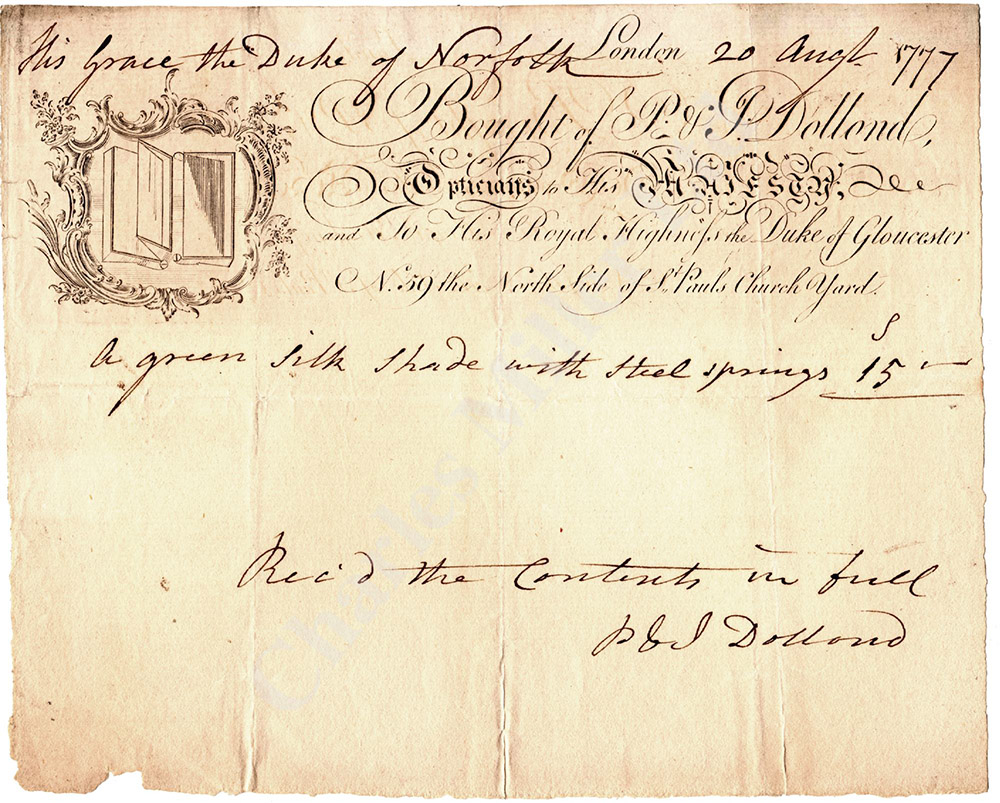
Figure 23.
A 1777 receipt of a sale from “P & J. Dollond” to the Duke of Norfolk. The “J.” was John Dollond, Jr., Peter’s brother. John Dollond Sr. died in 1761. Adapted for nonprofit, educational purposes.

Figure 24.
Circa 1840 trade label from George Dollond. Adapted for nonprofit, educational purposes from an internet sale site.
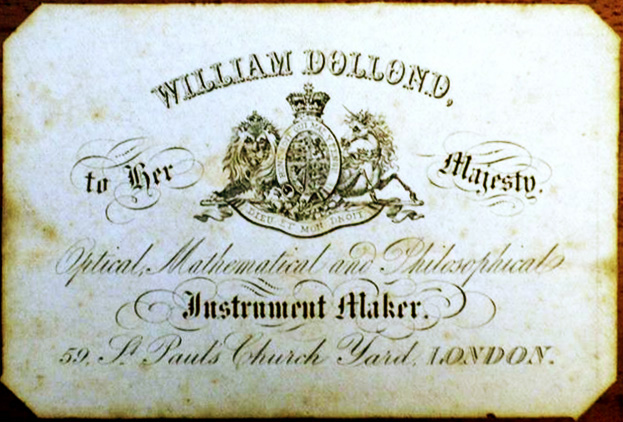
Figure 25.
Circa 1870 trade label from William Dollond. Adapted for nonprofit, educational purposes from an internet sale site.
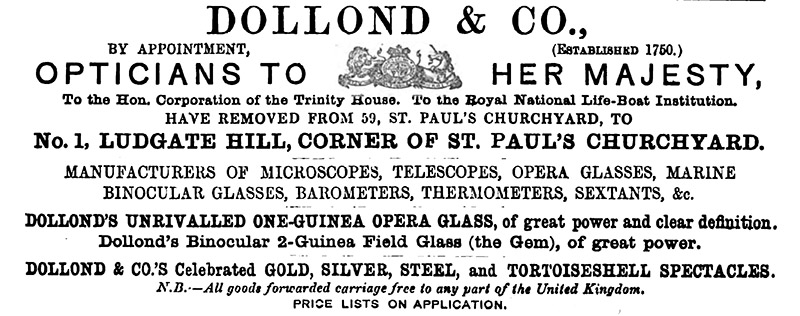
Figure 26.
An 1872 advertisement, noting the removal of Dollond and Company to 1 Ludgate Hill. This occurred shortly after William Dollond sold the family business to John Chant. From the March issue of Hardwicke’s Science-Gossip.
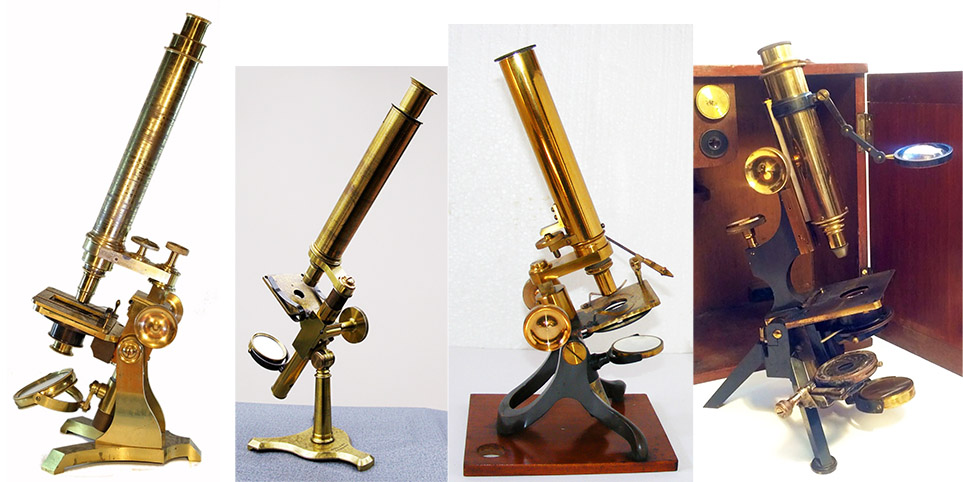
Figure 27.
A gathering of ca. 1870-1900 microscopes, all of which are inscribed with “Dollond” (not to scale). Numerous examples of these models are known that bear other names, suggesting that Dollond was their retailer, rather than the manufacturer. Images adapted for nonprofit, educational purposes from internet auction sites.
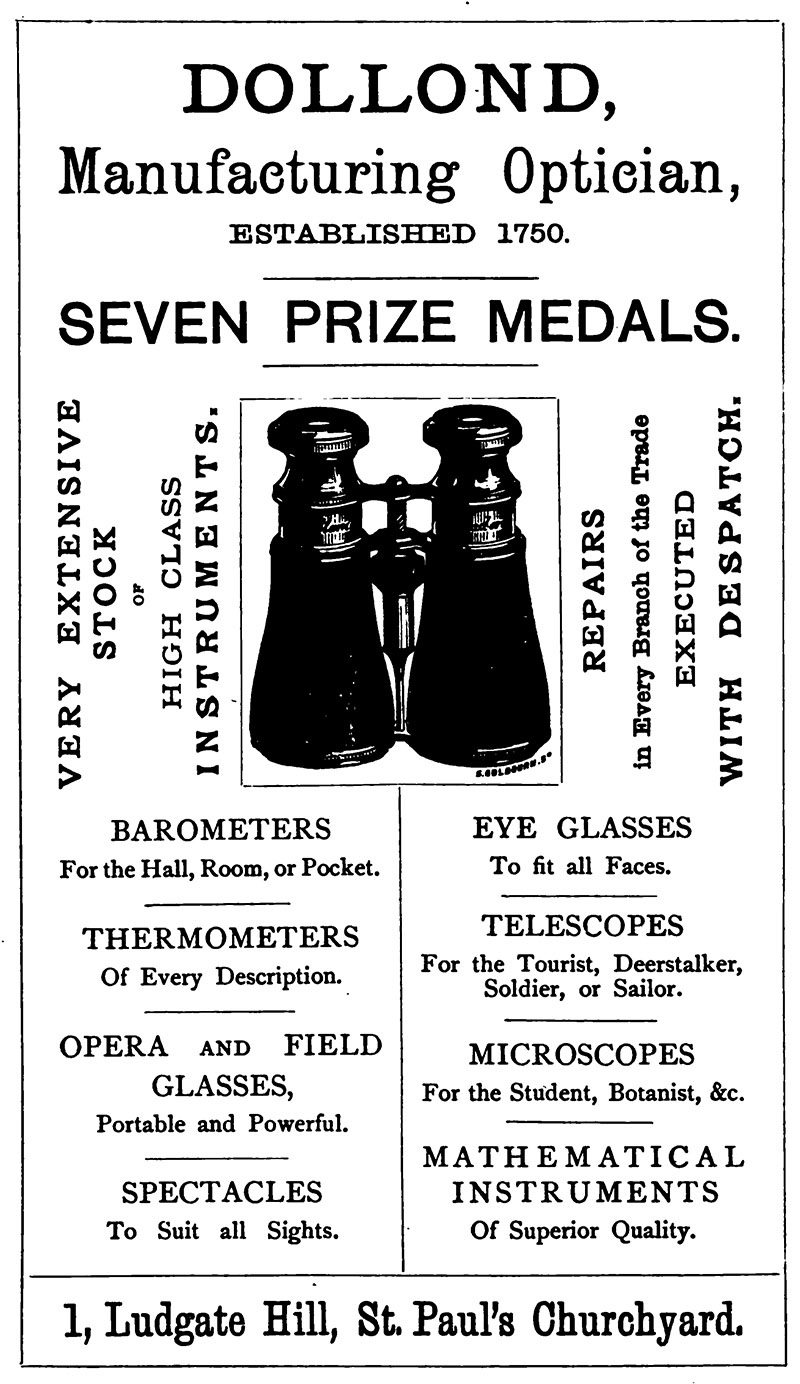
Figure 28.
An 1876 advertisement.
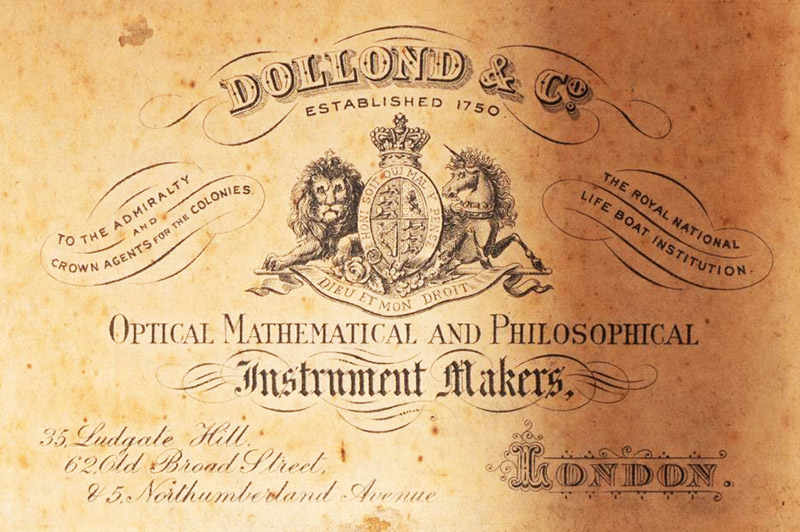
Figure 29.
A ca. 1900 Dollond & Co. trade label. Adapted for nonprofit, educational purposes from an internet auction site.
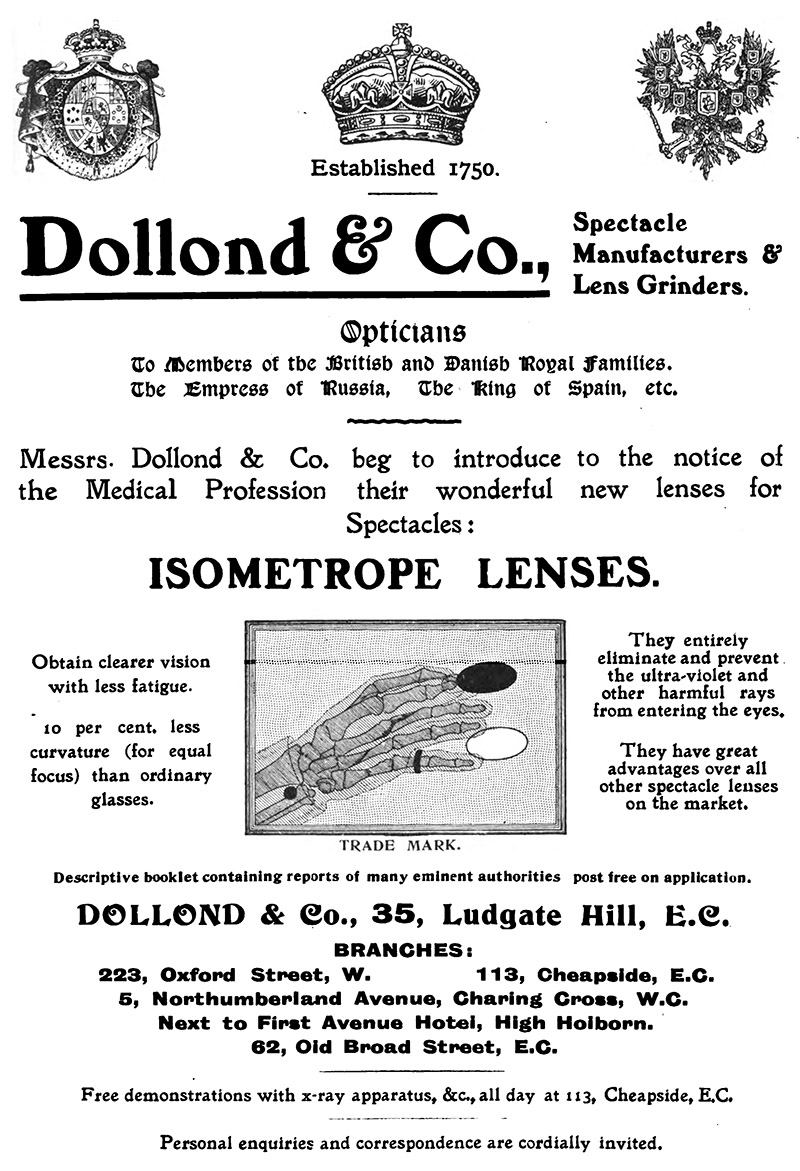
Figure 30.
A 1905 advertisement.
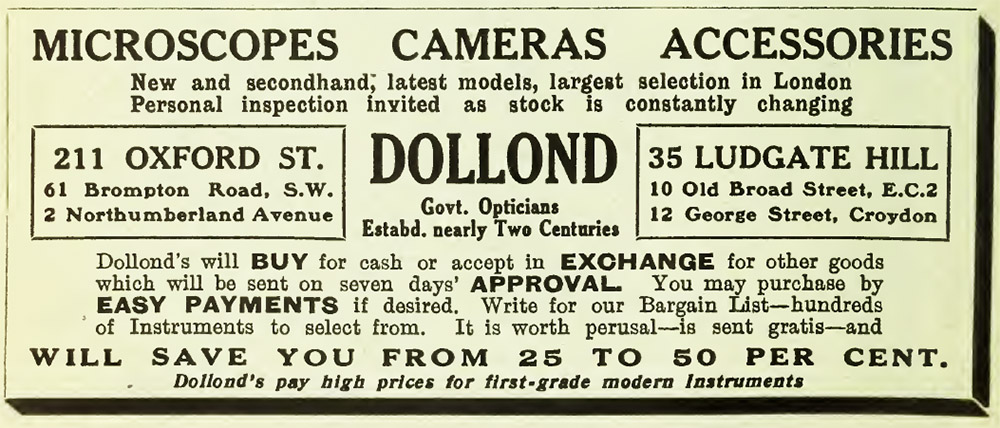
Figure 31.
A 1922 advertisement, from the “Journal of the Royal Microscopical Society”.
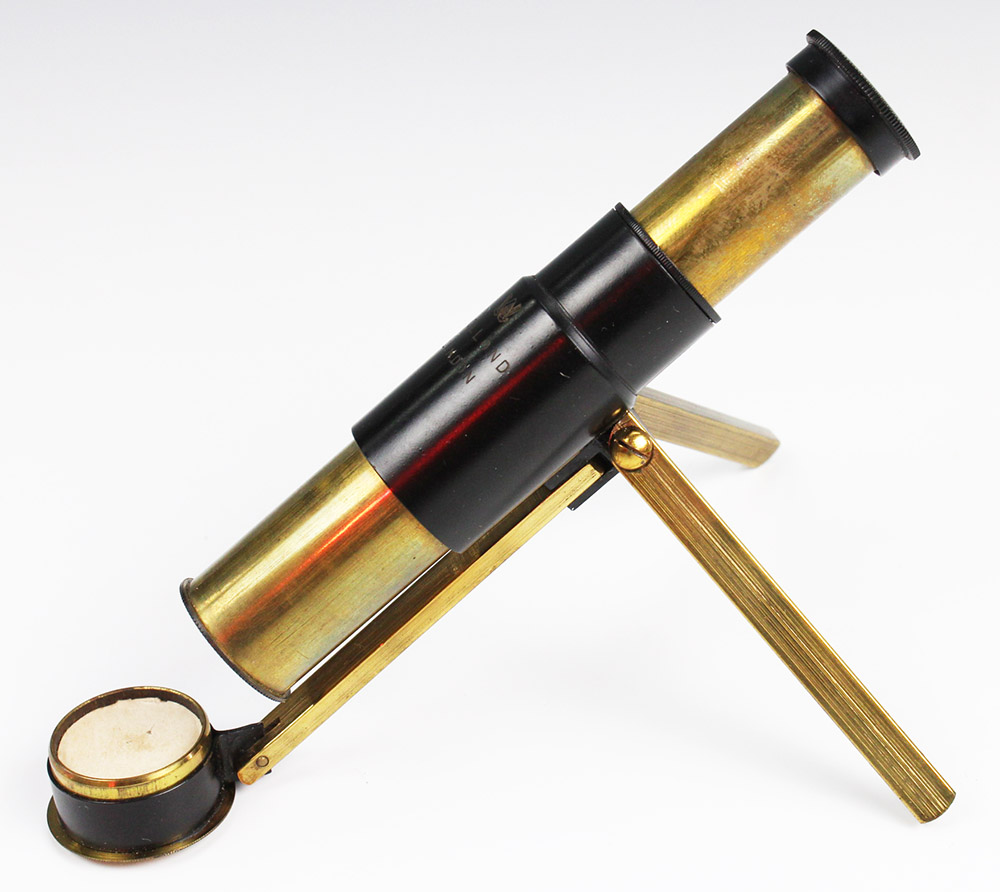
Figure 32.
Early twentieth century folding microscope, labeled as retailed by Dollond. Undoubtedly made by a wholesale manufacturer.
Resources
Agnew, David C.A. (1886) Protestant Exiles from France, Vol. 2, Third edition, page 459
Bracegirdle, Brian (1998) Microscopical Mounts and Mounters, Quekett Microscopical Club, London, pages 32 and 130, Plate 13-P
The British Cyclopedia of Biography (1837) Dollond, John, Vol. 1, page 591
Dictionary of National Biography (1888) Dollond, George, pages 195-196
Dictionary of National Biography (1888) Dollond, John, pages 196-198
Dictionary of National Biography (1888) Dollond, Peter, pages 198-199
Dollond, George (1823) A short account of a new instrument for measuring vertical and horizontal angles, Memoirs of the Royal Astronomical Society, Vol. 2, pages 125-128
Dollond, Peter (1789) Some Account of the Discovery, Made by the Late J. Dollond, F.R.S, Which Led to the Grand Improvement of Refracting Telescopes, Dollond, London
The Electrician (1892) “Dissolution of partnerships: ... Messrs. Chant and Crawford, trading as Dollond and Co., electrical and scientific apparatus makers, Ludgate Hill, E.C. Mr. Tyson Crawford will pay all debts and continue the business”, Vol. 28, page 441
England census and other records, accessed through ancestry.com
The European Magazine, and London Review (1820) Peter Dollond, Vol. 78, pages 99-102
Gee, Brian (2016) Francis Watkins and the Dollond Telescope Patent Controversy, Routledge, Abingdon
The Gentlemans’ Magazine (1820) Peter Dollond, Vol. 128, pages 90-91
The Gentlemans’ Magazine (1852) George Dollond, Vol. 192, pages 98-99
Hardwicke's Science-Gossip (1872) Advertisement from Dollond & Co., March issue
Journal of the Royal Microscopical Society (1922) Advertisement from Dollond & Co.
Kelly, John (1808) The Life of John Dollond, Kelly, London
Nuttall, R.H. (1979) Microscopes from the Frank Collection, A. Frank, Jersey, pages 36 and 39
The Ophthalmoscope (1905) Advertisement from Dollond & Co., Vol. 3, page vii
The Penny Cyclopaedia of the Society for the Diffusion of Useful Knowledge (1838) Dollond, John, Vol. 9, pages 64-65
Probate of the will of George Dollond 2 (1866) “Dollond George. 20 October. The Will of George Dollond late of 59 St. Paul’s-churchyard in the City of London deceased who died 22 September 1866 at Aldwick near Bognor in the County of Sussex was proved at the Principal Registry by the oaths of William Dollond of 59 St. Paul’s-churchyard aforesaid Optician the Son and Mercy Simpson Dollond of 59 St. Paul’s-churchyard aforesaid Spinster the Daughter the Executor”, accessed through ancestry.com
The Saturday Magazine (1840) Spitalfields in 1780 and 1840, Vol. 16, page 160
Treloar, William Purdie (1876) Ludgate Hill, Past and Present, Advertisement from Dollond & Co.
Will of Peter Dollond (1820) accessed through ancestry.com
Will of George Huggins Dollond (1852) accessed through ancestry.com

































